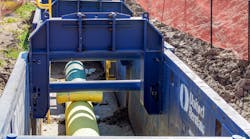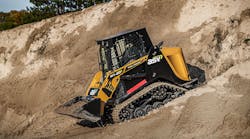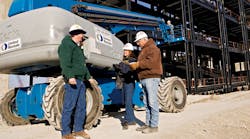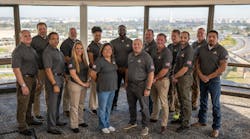Equipment Rental Activity Jumps 9 Percent in Second Quarter, Baird/RER Survey Respondents Say
Overall equipment rental activity increased 9 percent in the second quarter of 2021 compared to the second quarter of 2020, according to respondents in the quarterly Baird/RER equipment rental survey. The response in the quarter was 2 percent higher than the response in the second quarter of 2019. Positives in the quarter included a return to normal driving nonresidential construction; a robust residential homeowners’ market; a revival of demand in the party and event rental market; oil and gas activity improving for some; and no significant weather issues during the quarter. The majority of respondents experienced improving end-market demand as activity returns to normal, although the positives were somewhat offset by widespread labor shortages, material inflation and elongated new equipment procurement lead times, leaving some potential rental demand unfulfilled.
Average rental revenue increased 8.9 percent year over year, slightly less than the magnitude of the decline from the second quarter of 2020. Respondents reported revenue increased 2.1 percent compared to the second quarter of 2019, implying that revenue in 2Q21 more than offset the prior year decline for this survey respondent base. Worker shortages and material cost inflation were recurring themes. The second quarter of 2021 was in line to be better than expected with 59 percent saying revenue was in line with expectations and a net of 18 percent reporting revenue ahead of initial expectations.
Average rental rates were up 1.4 percent year over year, less than the magnitude of the decline from 2Q20. Improvement in rental demand and improved equipment utilization provided pricing flexibility.
Fleet utilization was 61.3 percent, up about 350 basis points sequentially and year over year. Utilization is up year over year for the second consecutive quarter. Challenges in procuring new equipment is lifting the utilization of existing equipment.
The cost of new units increased 4.5 percent, the highest growth since 2Q15, and roughly equal to the increase in the third quarter of 2018. Higher equipment prices are not only a factor of rising input costs in items such as steel, freight and labor but a function of improved OEM pricing power, according to the Baird analysis.
Respondents are forecasting healthy and improving expectations, essentially going back to “pre-Covid” operating dynamics. Rental fleets are stabilizing with units slightly higher than 2020 levels. Robust capex spending is expected in the second half of 2021.
Respondents are expecting third quarter rental revenue to jump 7.1 percent, with 2021 revenue expected to increase 8 percent, up from the 5 percent forecast in the previous two quarterly surveys. Respondents expect 2021 rental rates to increase 2.5 percent, similar to the pre-Covid trend.
Respondents expect fleet spending to rise 8.3 percent over the next six months. Spending on access equipment is expected to rise 9.9 percent, while spending on earthmoving equipment is expected to go up 5.7 percent.
While demand for equipment is increasing, 65 percent of respondents are seeing longer lead times for access equipment and are ordering ahead of normal demand patterns; 27 percent are seeing longer lead times but are ordering as planned. For earthmoving equipment, 84 percent of respondents are ordering ahead because of longer lead times.
Average rental revenue increased 8.9 percent year over year, which is slightly less than the decline from the second quarter of 2020. Respondents reported revenue increased 2.1 percent compared to the second quarter of 2019, implying that revenue in the second quarter of 2021 more than offset the prior year decline for the survey respondent base. Worker shortages and material cost inflation were recurring themes.
Respondents are expecting a 7.1-percent revenue hike in the third quarter of 2021. Forty-eight percent of respondents expect a 1 to 10 percent revenue increase, with 8 percent expecting a 1 to 5 percent jump and 40 percent forecasting a 5 to 10 percent leap. Ten to 20 percent expect a revenue increase of 10 to 20 percent, while lapping COVID-related shutdowns in the prior year.
“Limited access to new equipment and extended lead times for parts to repair equipment is helping to drive rental demand up,” said one respondent. “We are hearing that these delays may last into Q3 2022.”
“When Covid hit, our rental department doubled revenues for several months in a row,” said another. “This large increase may be hard to continue but with contractors being so busy, we are seeing homeowners doing more jobs themselves thus keeping rental revenues close to or above last year’s Covid boom.”
Average rental rates are up 1.4 percent year over year, less than the magnitude of the decline from the second quarter of 2020. Rental rates are expected to increase 2.5 percent in 2021 compared to roughly +1.5 percent expectations the prior two quarters.
The utilization rate for access equipment rose to 64.5 percent from 57.4 percent in the second quarter of 2020, while the utilization rate for earthmoving equipment rose to 63.5 percent from 63.1 percent in the second quarter of 2020. Small iron utilization rose to 52.2 percent from 48.8 percent a year ago.
Growth in the cost of new units increased 4.5 percent, the highest since the second quarter of 2015. It appears that OEMs are aggressively increasing equipment pricing to offset cost inflation, including record high steel prices, directionally consistent with the May PPI release.
The average fleet size, in terms of units, increased 1.5 percent year over year in the second quarter of 2021, the first growth in five quarters – from the second quarter of 2020 through the first quarter of 2021 are the only four quarters the average fleet size has declined in survey history.
As mentioned, access equipment spending is expected to rise 9.9 percent over the next six months (strongest expected growth in survey history) and earthmoving equipment up 5.7 percent, and small iron up 7.9 percent. Based on commentary, it appears fleet purchases would be higher if more equipment was available.
“Can’t get equipment or parts,” said one respondent.
“We stopped selling used fleet until new equipment is available,” said another.
The majority of respondents do not expect a material pickup in demand from the oil & gas end market. Despite oil prices reaching $70 per barrel for the first time in multiple years and the rig count gradually increasing, the majority of respondents that have oil & gas exposure do not expect an improvement in demand from the oil & gas end market during the second half of 2021.








